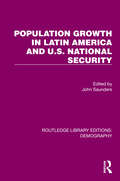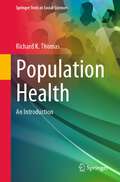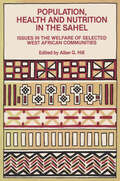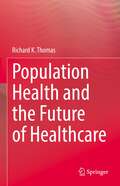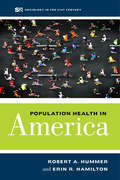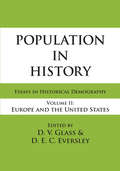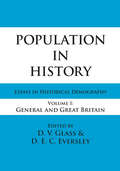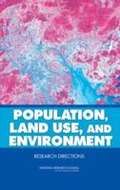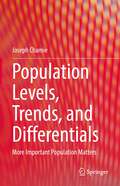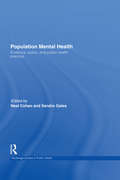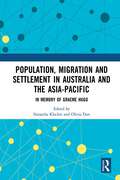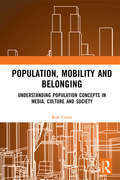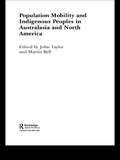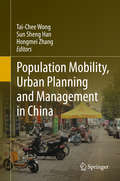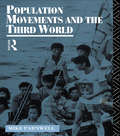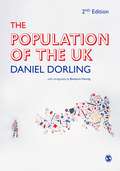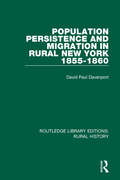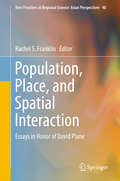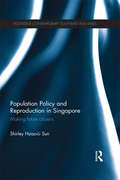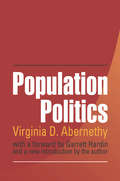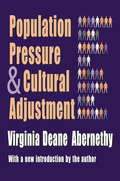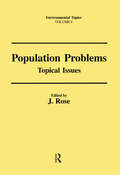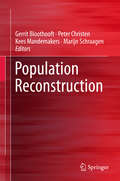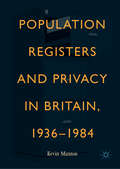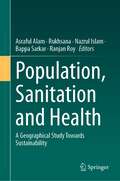- Table View
- List View
Population Growth In Latin America And U.S. National Security (Routledge Library Editions: Demography #11)
by John SaundersOriginally published in 1986, this volume deals with both population growth in Latin America and the possible consequences of this growth for the security of the USA. The text analyses the demographic dimensions of the phenomenon and then considers the consequences for US security. It was the first time that the interrelations between national security and population growth were systematically analyzed. The book predicts the raid population growth would have serious economic, social and strategic implications for the USA and rightly predicts the adoption of draconian measures to stem the flow of illegal migrants. Although some aspects of the political landscape have changed since original publication the issue of migration to the USA from Latin America has lost none of its relevance.
Population Health: An Introduction (Springer Texts in Social Sciences)
by Richard K. ThomasThis book provides a basic understanding and concise overview of the nature of population health, the factors that make a new paradigm necessary, and the attributes associated with this unique approach to community health improvement. Written in a very accessible way, the book describes the definition of population health, the attributes of population health, and what population health is and is not. It emphasizes the extent to which the population health model revolutionizes the approach to community health improvement within a contemporary context, beginning with a redefining of such common concepts as “health”, “healthcare”, “health status”, and “health needs assessment”. As such, this book is a valuable read for practitioners and professionals who need to be familiar with the population health approach but are not likely to try to implement it.
Population, Health and Nutrition in the Sahel: Issues in the Welfare of Selected West African Communities (Routledge Library Editions: Development Ser.)
by Allan G. HillThis collection of studies, first published in 1985, describes some contemporary problems of selected pastoral and agro-pastoral communities of the West African Sahel. Several important features of the Sahel are illustrated: the significance of seasonal factors in causing periodic stress amongst people and animals, the economic uncertainty introduced by interannual climactic variations, as well as the role of traditional systems of social and economic organisation in providing some support during periods of need. The findings presented here are published in co-operation with the Sahel Institute, a regional research organisation set up in the early 1970s with representation from eight Sahelian countries - Cape Verde, Chad, Gambia, Mali, Mauritania, Niger, Senegal and Upper Volta.
Population Health and the Future of Healthcare
by Richard K. ThomasStarting with a working definition, this comprehensive work defines the attributes of the population health model. It clarifies what population health is and is not. It discusses health disparities and the social determinants of health and illness and provides new ways of moving forward towards a more sustainable healthcare model in a changing society, thereby pointing out the importance of multi-sector collaboration for collective impact for community health improvement. The book takes this further by providing sources of data to support the population health model. As such, this book provides a must-read for students and anyone working, teaching or consulting in population healthcare.
Population Health in America (Sociology in the Twenty-First Century #5)
by Robert A. Hummer Erin R. HamiltonIn this engaging and accessibly written book, Population Health in America weaves demographic data with social theory and research to help students understand health patterns and trends in the U.S. population. While life expectancy was estimated to be just 37 years in the United States in 1870, today it is more than twice as long, at over 78 years. Yet today, life expectancy in the U.S. lags behind almost all other wealthy countries. Within the U.S., there are substantial social inequalities in health and mortality: women live longer but less healthier lives than men; African Americans and Native Americans live far shorter lives than Asian Americans and White Americans; and socioeconomic inequalities in health have been widening over the past 20 years. What accounts for these population health patterns and trends? Inviting students to delve into population health trends and disparities, demographers Robert Hummer and Erin Hamilton provide an easily understandable historical and contemporary portrait of U.S. population health. Perfect for courses such as population health, medical or health sociology, social epidemiology, health disparities, demography, and others, as well as for academic researchers and lay persons interested in better understanding the overall health of the country, Population Health in America also challenges students, academics, and the public to understand current health policy priorities and to ask whether considerably different directions are needed.
Population in History: Essays in Historical Demography, Volume II: Europe and United States
by Hugh DaunceyThis large-scale comparative endeavor, complete in two volumes, reflects increasing concern with the population factor in economic and social change worldwide. Demographers, on their side, have been focusing on history. In response to this, Population in History represents the work of two practitioners that have begun to work together, using their combined approaches in an attempt to assess and account for population growth experienced by the West since the seventeenth century.There is a long record of interest in the history of population. But the interest now displayed is likely to be both more persistent and far more fruitful in its consequences. New studies have been initiated in many countries. And because the studies are more informed and systematic than many of those of earlier periods, they are already provoking the further spread of research. A much more positive part is now also being played by national and international associations of historians and demographers. It is not unlikely that, within the next fifteen or twenty years, the main outlines of population change in the seventeenth and eighteenth centuries will be firmly established for much of Europe.Previous research has tended to appear in specialist journals and academic publications. This volume is intended to provide a more easily accessible publication. It has been thought appropriate to include some earlier work, both because of its intrinsic interest and because it provided the background and part of the stimulus to the later research. Of the twenty-seven contributions to this outstanding volume, seven are unabridged reprints of earlier work; the remaining contributions are either entirely new or represent substantial revisions of work published elsewhere.
Population in History: Essays in Historical Demography, Volume I: General and Great Britain
by D. V. Glass D. E. C. EversleyThis large-scale comparative endeavor, complete in two volumes, reflects increasing concern with the population factor in economic and social change worldwide. Demographers, on their side, have been focusing on history. In response to this, Population in History represents the work of two practitioners that have begun to work together, using their combined approaches in an attempt to assess and account for population growth experienced by the West since the seventeenth century.There is a long record of interest in the history of population. But the interest now displayed is likely to be both more persistent and far more fruitful in its consequences. New studies have been initiated in many countries. And because the studies are more informed and systematic than many of those of earlier periods, they are already provoking the further spread of research. A much more positive part is now also being played by national and international associations of historians and demographers. It is not unlikely that, within the next fifteen or twenty years, the main outlines of population change in the seventeenth and eighteenth centuries will be firmly established for much of Europe.Previous research has tended to appear in specialist journals and academic publications. This volume is intended to provide a more easily accessible publication. It has been thought appropriate to include some earlier work, both because of its intrinsic interest and because it provided the background and part of the stimulus to the later research. Of the twenty-seven contributions to this outstanding volume, seven are unabridged reprints of earlier work; the remaining contributions are either entirely new or represent substantial revisions of work published elsewhere.
Population, Land Use, And Environment: Research Directions
by Panel on New Research on Population the EnvironmentPopulation, Land Use, and Environment: Research Directions offers recommendations for future research to improve understanding of how changes in human populations affect the natural environment by means of changes in land use, such as deforestation, urban development, and development of coastal zones. It also features a set of state-of-the-art papers by leading researchers that analyze population-land useenvironment relationships in urban and rural settings in developed and underdeveloped countries and that show how remote sensing and other observational methods are being applied to these issues. This book will serve as a resource for researchers, research funders, and students.
Population Levels, Trends, and Differentials: More Important Population Matters
by Joseph ChamieThis book is a broad collection of short and concise chapters addressing important issues relating to population levels, trends, and differentials. In addition to traditional population concerns, such as growth, composition, fertility, mortality, and migration, the articles address a broad range of related issues, including climate change, environmental degradation, socio-economic development, and policy development. The articles are concise, focused on specific issues, and presented in a style that avoids technical jargon and is easily understood by a broad range of readers. The articles are not only aimed at conveying population information, but also providing important messages for informed policy formulation and program implementation. Among the many issues addressed are human rights, laws, women, gender, climate change, COVID-19 pandemic, ageing, retirement, and abortion. Written in an accessible way, the book will appeal to many general readers wishing to know more about population issues.
Population Mental Health: Evidence, Policy, and Public Health Practice
by Sandro Galea Neal CohenFirst Published in 2012. Routledge is an imprint of Taylor & Francis, an informa company.
Population, Migration and Settlement in Australia and the Asia-Pacific: In Memory of Graeme Hugo
by Natascha Klocker Olivia DunThe chapters in this book reflect on the work of seminal Australian geographer, the late Professor Graeme Hugo. Graeme Hugo was widely respected because of his impressive contributions to scholarship and policy in the fields of migration, population and development, which spanned several decades. This collection of works contains contributions from authors whose own research has been influenced by Hugo; and includes numerous authors who worked closely with Hugo throughout his career. The collection provides an opportunity to reflect on Hugo’s legacy, and also to foreground contemporary scholarship in his key areas of research focus. The chapters are organised into two thematic threads. Part I contains works relating to ‘Population, Migration and Settlement in Australia’, while Part II focuses on ‘Labour and Environmental Migration in the Asia-Pacific’. Together, these two thematic threads provide broad coverage of Graeme Hugo’s key areas of research focus. The chapters also serve as a reminder of Hugo’s steadfast concern with producing careful scholarship for the public good, and seek to prompt continued work in this vein. The chapters originally published in special issues in Australian Geographer.
Population, Mobility and Belonging: Understanding Population Concepts in Media, Culture and Society
by Rob CoverIn a world of increasing mobility and migration, population size and composition come under persistent scrutiny across public policy, public debate, and film and television. Drawing on media, cultural and social theory approaches, this book takes a fresh look at the concept of ‘population’ as a term that circulates outside the traditional disciplinary areas of demography, governance and statistics—a term that gives coherence to notions such as community, nation, the world and global humanity itself. It focuses on understanding how the concept of population governs ways of thinking about our own identities and forms of belonging at local, national and international levels; on the manner in which television genres fixate on depictions of overpopulation and underpopulation; on the emergence of questions of ethics of belonging and migration in relation to cities; on attitudes towards otherness; and on the use by an emergent ‘alt-right’ politics of population in ‘forgotten people’ concepts. As such, it will appeal to scholars of sociology, geography and media and cultural studies with interests in questions of belonging, citizenship and population.
Population Mobility and Indigenous Peoples in Australasia and North America (Routledge Research in Population and Migration)
by John Taylor Martin BellThis book draws together relevant research findings to produce the first comprehensive overview of Indigenous peoples' mobility. Chapters draw from a range of disciplinary sources, and from a diversity of regions and nation-states. Within nations, mobility is the key determinant of local population change, with implications for service delivery, needs assessment, and governance. Mobility also provides a key indicator of social and economic transformation. As such, it informs both social theory and policy debate. For much of the twentieth century conventional wisdom anticipated the steady convergence of socio-demographic trends, seeing this as an inevitable concomitant of the development process. However, the patterns and trends in population movement observed in this book suggest otherwise, and provide a forceful manifestation of changing race relations in these new world settings.
Population Mobility, Urban Planning and Management in China
by Tai-Chee Wong Sun Sheng Han Hongmei ZhangThis volume contains essays that examine contemporary urban and regional planning and development in China. Through in-depth theoretical and empirical analysis, it provides insights into the urban policies and operational mechanisms of this colossal transitional economy which has presented unprecedented challenges and dynamics. Inside, readers will discover the causes and consequences of rapid urbanization that have led to a series of environmental, economic and social planning and management measures designed to achieve quality urban living. The essays also detail efforts in adopting the latest options in city building such as specific urban planning approaches in developing large city regions, building cities without slums, constructing new townships and green urbanism, including eco-city and sustainable transport. In addition, coverage explores financial management and support as a means to encourage urbanization and urban economic growth in less-developed regions. Overall, the volume offers a wealth of concrete, detailed information on conditions in different regions of China and features an extensive range of content, methods and theory. It provides readers with a comprehensive portrait of the chain relationship between rapid urbanization, spatial planning and management throughout the country. The book will serve as a useful reference for national and international consultancy services doing business or serving public interest in China. It will also be of interest to an international audience seeking a better understanding of urban development and planning in China, including university teachers, students, government agencies and general readers.
Population Movements and the Third World (Routledge Introductions to Development)
by Mike ParnwellThe interrelationship between migration and development is complex. The causes of migration stem from the uneveness of the development process and the effects exert a powerful influence on the pattern and process of development. This volume explores both the concepts and facts behind the main forms of population movement in the third world today, particularly rural-urban migration. Examining the causes and consequences of migration, the author assesses the implications for planning and policy-makers.
The Population of the UK (Second Edition)
by Danny DorlingDid you know that where you were born may affect when you die? The Population of the UK explains how geography - in the widest sense - makes a difference to life outcomes. It explains the geographical differences in key socio-economic variables - like education, health, and work - that illustrate the UK's stark social inequalities and affect everyone's lives. Written for undergraduate students across social science disciplines, this unique text presents a social geography of the UK which: Contains over 100 maps. These are drawn in proportion to the numbers of people being depicted and so represent the human geography of the UK in a fair way. Visualises quantitative evidence. The very latest statistics from numerous sources - including the 2010 election - reveal the many aspects of the underlying geographical structure of society in the UK. Relates geographies of identity to geographies of inequality, mortality, work, and settlement, and in a final chapter shows how the UK's population fits in to the world picture of who has most of what, and where. Using the most advanced cartographic techniques of social mapping employed anywhere in the world, The Population of the UK explains the nuts and bolts of UK population in comparative context. A note on data: Much of the data comes from 2010 and 2011. However, because as yet only the age and sex data from the 2011 census has been released the book shows 2001 patterns where only census data can reveal it. As 2011 census data is released, Danny plans to update the maps on-line.
Population Persistence and Migration in Rural New York, 1855-1860 (Routledge Library Editions: Rural History #4)
by David Paul DavenportThis title, first published in 1989, explores the population change in America during the 1800s by closely examining frontier settlement, urbanisation, and depopulation and emigration from rural areas of the north-eastern United States. Population Persistence and Migration in Rural New York, 1855-1860 will be of interest to students of history and human geography.
Population, Place, and Spatial Interaction: Essays in Honor of David Plane (New Frontiers in Regional Science: Asian Perspectives #40)
by Rachel S. FranklinThis volume is devoted to the geographical—or spatial—aspects of population research in regional science, spanning spatial demographic methods for population composition and migration to studies of internal and international migration to investigations of the role of population in related fields such as climate change and economic growth. If spatial aspects of economic growth and development are the flagship of the regional science discipline, population research is the anchor. People migrate, consume, produce, and demand services. People are the source and beneficiaries of national, regional, and local growth and development. Since the origins of regional science, demographic research has been at the core of the discipline. Contributions in this volume are both retrospective and prospective, offering in their ensemble an authoritative overview of demographic research within the field of regional science.
Population Policy and Reproduction in Singapore: Making Future Citizens (Routledge Contemporary Southeast Asia Series)
by Shirley Hsiao-Li SunThis book examines the relationship between population policies and individual reproductive decisions in low-fertility contexts. Using the case study of Singapore, it demonstrates that the effectiveness of population policy is a function of competing notions of citizenship, and the gap between seemingly neutral policy incentives and the perceived and experienced disparate effects. Drawing on a substantial number of personal interviews and focus groups, the book analyzes the developmental welfare state’s overarching emphasis of citizen responsibility, and examines population policies that reinforce social inequalities and ignore cultural diversity. These factors combine to undermine elaborate state policy efforts in encouraging citizens’ biological reproduction. The book goes on to argue that in order to facilitate positive fertility decisions, the state needs to modify the “economic production at all cost” approach and pay much more attention to the importance of social rights. This suggests that the Singapore government might profitably approach the phenomenon of very low fertility with major initiatives similar to those of other advanced industrialized societies. This book offers a significant contribution to the literature on social policy, East Asian and Southeast Asian studies.
Population Politics: The Choices That Shape Our Future
by Virginia Abernethy Garrett HardinInternational efforts to regulate fertility rates so that populations do not grow beyond the earth's capacity have included technical assistance and capital; improved health care conditions to lower the risk of infant mortality; increased opportunities to develop literacy; the democratization of governments; and several decades of liberal immigration and refugee policies favoring third world nations. The persistence of high fertility despite international efforts confounds demographers. 'Population Politics' brilliantly dissects the paradigm responsible for the counterproductive efforts of nations and international agencies. Abernethy, a renowned anthropologist, shows why policies hamper the shift to lower fertility. Ireland, Indonesia, Cuba, China, Turkey and Egypt are but a few of the countries Abernethy examines, showing how economic, sociocultural, and agricultural factors that have caused population growth can be harnessed to stabilize population size. 'Population Politics' is a provocative examination of the influence of aid and liberal immigration policies on world population growth, and often counterproductive to the role of the United States as an industrial power. This volume's uniquely interdisciplinary perspective will enlighten the lay reader, as well as demographers and epidemiologists, conservationists, reproduction and family specialists, agricultural economists, and public health personnel. Virginia D. Abernethy is professor emeritus of psychiatry (anthropology) at Vanderbilt Medical School and was for 11 years the editor of the scholarly journal 'Population and Environment. Garrett Hardin is emeritus professor of human ecology in the Department of Biological Sciences and the University of California, Santa Barbara.
Population Pressure and Cultural Adjustment
by Virginia Deane AbernethyIntegrating research from anthropology, biology, and history, this provocative, brilliant book proposes a theory of demographic equilibrium. The author's hypothesis is that human beings, like many other species, are able to adjust their population numbers to the carrying capacity of the environment. Abernethy points out that in response to perception of scarcity or abundance of resources, culturally mediated values, beliefs and behavioral patterns are modified in ways that can either raise or lower rates of population growth. Abernethy in this way moves beyond the ideological debates that have sundered the field of policy and population. In real world time and space, cultural adjustments that balance population and resources are made over a long stretch in relatively stable or known environments. These adjustments also operate in processes that involve technological advances that appear to increase carrying capacity, and these usually act to support and underwrite population growth in any given area. In her new introduction to this first paperback edition, Abernethy shows how many of the cultural changes the book predicted in 1979 have come to pass. She details a complex of behaviors that favor single life-styles or small family size that have contributed to low fertility rates among native-born Americans while fertility rates among immigrants continue to climb. Population Pressure and Cultural Adjustment is not simply a theoretical slogan, but discusses a rich set of different cultural situations where this homeostatic process has been disrupted or aborted. Often, disruption occurs after the infusion of foreign value systems as well as new forms of technological innovation, or when highly permeable social boundaries result in the importation of resources for which the limits and consequences are not fully appreciated by the host population. This work will inevitably be controversial because of its implications for the limits as well as the potential of public policy in both advanced and underdeveloped societies.
Population Problems: Topical Issues (Environmental Topics Ser. #Vol. 8)
by J. RoseThe effects of the rapidly expanding human population on the environment and the planet's future is a matter of increasing concern and lively debate. This timely collection of essays discusses some of the most important aspects of the population growth phenomenon and offers potential solutions. Chapters analyse population dynamics, carrying capacity of the environment, water and food supply, effects on tribal societies, and the AIDS pandemic.
Population Reconstruction
by Gerrit Bloothooft Peter Christen Kees Mandemakers Marijn SchraagenThis book addresses the problems that are encountered, and solutions that have been proposed, when we aim to identify people and to reconstruct populations under conditions where information is scarce, ambiguous, fuzzy and sometimes erroneous. The process from handwritten registers to a reconstructed digitized population consists of three major phases, reflected in the three main sections of this book. The first phase involves transcribing and digitizing the data while structuring the information in a meaningful and efficient way. In the second phase, records that refer to the same person or group of persons are identified by a process of linkage. In the third and final phase, the information on an individual is combined into a reconstruction of their life course. The studies and examples in this book originate from a range of countries, each with its own cultural and administrative characteristics, and from medieval charters through historical censuses and vital registration, to the modern issue of privacy preservation. Despite the diverse places and times addressed, they all share the study of fundamental issues when it comes to model reasoning for population reconstruction and the possibilities and limitations of information technology to support this process. It is thus not a single discipline that is involved in such an endeavor. Historians, social scientists, and linguists represent the humanities through their knowledge of the complexity of the past, the limitations of sources, and the possible interpretations of information. The availability of big data from digitized archives and the need for complex analyses to identify individuals calls for the involvement of computer scientists. With contributions from all these fields, often in direct cooperation, this book is at the heart of the digital humanities, and will hopefully offer a source of inspiration for future investigations.
Population Registers and Privacy in Britain, 1936—1984
by Kevin MantonThis book examines the fraught political relationship between British governments, which wanted information about peoples’ lives, and the people who desired privacy. To do this it looks at something that Britain only experienced in wartime, a centralized and up-to-date list of everyone in the country: a population register. The abolition of this wartime system is contrasted with later attempts to reintroduce registration, and the change in the political mind-set driving these later schemes to develop centralised webs of so-called objective data is examined. These policies were confronted by privacy campaigns, studied here, but it is shown how government responses succeeded in turning political debates about data into technical discussions about computerization; thus protecting its data, largely on paper, from oversight. This reformulation also shaped the 1984 Data Protection Act, which consequently did not protect privacy but rather increased government’s ability to gain knowledge of, and hence power over, the people.
Population, Sanitation and Health: A Geographical Study Towards Sustainability
by Asraful Alam Rukhsana Nazrul Islam Bappa Sarkar Ranjan RoyThis book provides analyses of sanitation, health, population dynamics and demographic variables from different perspectives, including data science, statistics, modeling, economics and natural sciences, to inform sustainable decision making and policies related public health and hygiene and in mainly rural and impoverished areas. The structure is arranged into three broad sections: Part I, Population Dynamics, Environment and Society; Part II, Health, Livelihood and Policy Response; and Part III, Water, Sanitation, and Hygiene (WASH). The book makes recommendations for policymakers on designing and delivering social protection policies to deal with different aspects of water, health, sanitation, population, and hygiene, taking the needs of women and rural communities into special consideration. It also aims to educate students and early career researchers, to help them develop novel approaches for sustainability with environmentally sound practices.
